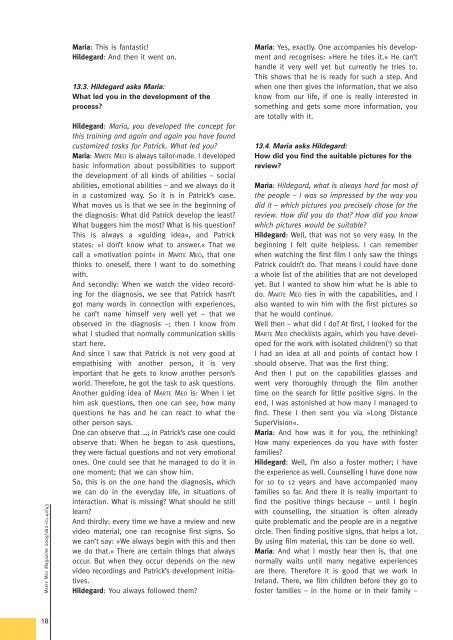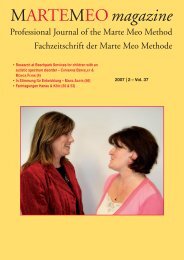Marte Meo in der Paarberatung
Marte Meo in der Paarberatung
Marte Meo in der Paarberatung
Sie wollen auch ein ePaper? Erhöhen Sie die Reichweite Ihrer Titel.
YUMPU macht aus Druck-PDFs automatisch weboptimierte ePaper, die Google liebt.
MARTE MEO Magaz<strong>in</strong>e 2009/1&2-VOL.42/43<br />
18<br />
Maria: This is fantastic!<br />
Hildegard: And then it went on.<br />
13.3. Hildegard asks Maria:<br />
What led you <strong>in</strong> the development of the<br />
process?<br />
Hildegard: Maria, you developed the concept for<br />
this tra<strong>in</strong><strong>in</strong>g and aga<strong>in</strong> and aga<strong>in</strong> you have found<br />
customized tasks for Patrick. What led you?<br />
Maria: MARTE MEO is always tailor-made. I developed<br />
basic <strong>in</strong>formation about possibilities to support<br />
the development of all k<strong>in</strong>ds of abilities – social<br />
abilities, emotional abilities – and we always do it<br />
<strong>in</strong> a customized way. So it is <strong>in</strong> Patrick’s case.<br />
What moves us is that we see <strong>in</strong> the beg<strong>in</strong>n<strong>in</strong>g of<br />
the diagnosis: What did Patrick develop the least?<br />
What buggers him the most? What is his question?<br />
This is always a »guid<strong>in</strong>g idea«, and Patrick<br />
states: »I don’t know what to answer.« That we<br />
call a »motivation po<strong>in</strong>t« <strong>in</strong> MARTE MEO, that one<br />
th<strong>in</strong>ks to oneself, there I want to do someth<strong>in</strong>g<br />
with.<br />
And secondly: When we watch the video record<strong>in</strong>g<br />
for the diagnosis, we see that Patrick hasn’t<br />
got many words <strong>in</strong> connection with experiences,<br />
he can’t name himself very well yet – that we<br />
observed <strong>in</strong> the diagnosis –; then I know from<br />
what I studied that normally communication skills<br />
start here.<br />
And s<strong>in</strong>ce I saw that Patrick is not very good at<br />
empathis<strong>in</strong>g with another person, it is very<br />
important that he gets to know another person’s<br />
world. Therefore, he got the task to ask questions.<br />
Another guid<strong>in</strong>g idea of MARTE MEO is: When I let<br />
him ask questions, then one can see, how many<br />
questions he has and he can react to what the<br />
other person says.<br />
One can observe that …; <strong>in</strong> Patrick’s case one could<br />
observe that: When he began to ask questions,<br />
they were factual questions and not very emotional<br />
ones. One could see that he managed to do it <strong>in</strong><br />
one moment; that we can show him.<br />
So, this is on the one hand the diagnosis, which<br />
we can do <strong>in</strong> the everyday life, <strong>in</strong> situations of<br />
<strong>in</strong>teraction. What is miss<strong>in</strong>g? What should he still<br />
learn?<br />
And thirdly: every time we have a review and new<br />
video material, one can recognise first signs. So<br />
we can’t say: »We always beg<strong>in</strong> with this and then<br />
we do that.« There are certa<strong>in</strong> th<strong>in</strong>gs that always<br />
occur. But when they occur depends on the new<br />
video record<strong>in</strong>gs and Patrick’s development <strong>in</strong>itiatives.<br />
Hildegard: You always followed them?<br />
Maria: Yes, exactly. One accompanies his development<br />
and recognises: »Here he tries it.« He can’t<br />
handle it very well yet but currently he tries to.<br />
This shows that he is ready for such a step. And<br />
when one then gives the <strong>in</strong>formation, that we also<br />
know from our life, if one is really <strong>in</strong>terested <strong>in</strong><br />
someth<strong>in</strong>g and gets some more <strong>in</strong>formation, you<br />
are totally with it.<br />
13.4. Maria asks Hildegard:<br />
How did you f<strong>in</strong>d the suitable pictures for the<br />
review?<br />
Maria: Hildegard, what is always hard for most of<br />
the people – I was so impressed by the way you<br />
did it – which pictures you precisely chose for the<br />
review. How did you do that? How did you know<br />
which pictures would be suitable?<br />
Hildegard: Well, that was not so very easy. In the<br />
beg<strong>in</strong>n<strong>in</strong>g I felt quite helpless. I can remember<br />
when watch<strong>in</strong>g the first film I only saw the th<strong>in</strong>gs<br />
Patrick couldn’t do. That means I could have done<br />
a whole list of the abilities that are not developed<br />
yet. But I wanted to show him what he is able to<br />
do. MARTE MEO ties <strong>in</strong> with the capabilities, and I<br />
also wanted to w<strong>in</strong> him with the first pictures so<br />
that he would cont<strong>in</strong>ue.<br />
Well then – what did I do? At first, I looked for the<br />
MARTE MEO checklists aga<strong>in</strong>, which you have developed<br />
for the work with isolated children( 4 ) so that<br />
I had an idea at all and po<strong>in</strong>ts of contact how I<br />
should observe. That was the first th<strong>in</strong>g.<br />
And then I put on the capabilities glasses and<br />
went very thoroughly through the film another<br />
time on the search for little positive signs. In the<br />
end, I was astonished at how many I managed to<br />
f<strong>in</strong>d. These I then sent you via »Long Distance<br />
SuperVision«.<br />
Maria: And how was it for you, the reth<strong>in</strong>k<strong>in</strong>g?<br />
How many experiences do you have with foster<br />
families?<br />
Hildegard: Well, I’m also a foster mother; I have<br />
the experience as well. Counsell<strong>in</strong>g I have done now<br />
for 10 to 12 years and have accompanied many<br />
families so far. And there it is really important to<br />
f<strong>in</strong>d the positive th<strong>in</strong>gs because – until I beg<strong>in</strong><br />
with counsell<strong>in</strong>g, the situation is often already<br />
quite problematic and the people are <strong>in</strong> a negative<br />
circle. Then f<strong>in</strong>d<strong>in</strong>g positive signs, that helps a lot.<br />
By us<strong>in</strong>g film material, this can be done so well.<br />
Maria: And what I mostly hear then is, that one<br />
normally waits until many negative experiences<br />
are there. Therefore it is good that we work <strong>in</strong><br />
Ireland. There, we film children before they go to<br />
foster families – <strong>in</strong> the home or <strong>in</strong> their family –



